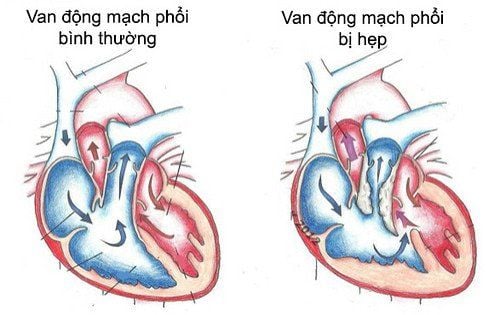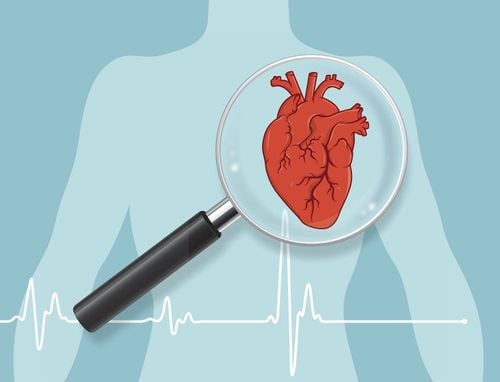This is an automatically translated article.
The article is professionally consulted by Master, Doctor Pham Van Hung - Department of Medical Examination & Internal Medicine - Vinmec Danang International General Hospital.
Percutaneous balloon dilation is a non-surgical treatment for valvular stenosis. This is a simple procedure, minimally invasive, the patient remains fully awake during the procedure and the recovery time is very fast. Let's find out the basic information about this technique in the article below.
1. How to perform angioplasty?
The heart is like a "pump" with the task of pumping blood throughout the body. In it, the heart valves keep blood flowing in a certain direction from the atria to the ventricles and from the ventricles into the great arteries. If the valve leaflets are not fully opened, the blood flow will be blocked, not fully drained to go out, so it will stagnate behind, causing stenosis of the heart valve. Patients often experience fatigue, palpitations, heart palpitations, shortness of breath on exertion or lying down, sudden shortness of breath at night while sleeping, chest pain, dry cough, coughing up blood, or sometimes fainting.At this time, the main treatment is intervention on the valve, both to help release the blockage and improve the symptoms for the patient. Accordingly, instead of needing surgery to replace an artificial heart valve or repair it directly on the valve, with narrow heart valves simply due to sticking to the valve margin, the method being applied today is percutaneous balloon angioplasty. .
To perform angioplasty, the doctor inserts a tube into the femoral vein just below the inguinal fold. From here, the tube follows the inferior vena cava back to the heart. In the right atrium, the catheter will pass through the atrial septum to the left atrium and reach the opening of the mitral valve. At the position where the valve leaflets are stuck to the edge, narrowing the flow through the valve, the inflatable balloon on the top of the tube will be inflated and deflated in increasing size to expand the waist of the balloon, separating the valves. until the desired dilatation result is achieved. After that, the balloon will be deflated to shrink before being withdrawn. From there, the blood flow through the heart will be opened without very limited intervention on the patient, the hospital stay is significantly shortened.
For aortic stenosis, the approach is similar to mitral stenosis but enters by the femoral artery. However, this method is less commonly used because aortic stenosis has an additional less invasive treatment method, which is percutaneous valve replacement.
2. In which case is angioplasty applied?

In which, the standard to be dilated valve is relatively strict. Indicated cases include:
Tight mitral stenosis with an ultrasonic orifice of less than 1.5 cm2 and clinical symptoms: fatigue, dyspnea on exertion and even at rest . Valve morphology on echocardiography is good for percutaneous balloon dilation based on Wilkins's scale for features of mobility, leaflet thickness, associated ligamentous injury, and calcification of the valvular apparatus. shared. There was no thrombus in the left atrium on transthoracic echocardiography or preferably on transesophageal echocardiography. The mitral valve was not damaged causing regurgitation and left ventricular function was preserved. Conversely, percutaneous balloon dilation should not be performed if the patient has one of the following contraindications:
Mitral stenosis with mitral regurgitation. New thrombus in the left atrium or left atrium. Therefore, the decision of percutaneous balloon valvuloplasty should be considered very carefully, consulting many experts on the basis of clinical examination, transthoracic ultrasound and transesophageal ultrasound many times to ensure High success rate for this method.
3. Advantages and limitations of angioplasty
3.1 Advantages If the patient's valvular apparatus is suitable for angioplasty and has no contraindications, this method will be preferred because it has a high success rate and few complications.This is a less invasive procedure, with many advantages compared to surgery such as short hospital stay, less pain, no scar on the chest, patient psychology is also more comfortable. Even valvular dilation can be performed in some special situations where the surgery is difficult to succeed completely or the risk is high, such as in pregnant women, in people with severe heart failure, in patients in acute condition. assist.
After the intervention, the area of the orifice is significantly enlarged, the obstruction of blood flow through the valve is removed, so the clinical symptoms and hemodynamic status are significantly improved. In addition, in terms of long-term effectiveness, the results of angioplasty are maintained equivalent to or even better than those of surgical repair.
3.2 Limitations Despite this, valvular angioplasty is not entirely free from certain complications. The reported mortality rate is less than 1% due to acute tamponade or acute stroke. Acute cardiac tamponade is caused by incorrect puncture of the atrial septum causing atrial or ventricular perforation, resulting in massive pericardial hemoperitoneum.
Acute stroke and other embolisms are caused by embolism by thrombus in the left atrium and atrium entering the systemic circulation. In addition, angioplasty can also cause mitral regurgitation or residual atrial septal defect if the stoma does not close on its own within 6 months. Severe valvular regurgitation or large septal defect are very difficult to tolerate long term limitations.

4. Why should percutaneous balloon dilation at Vinmec?
Cardiovascular disease is generally a complex specialty, in which surgical interventions on heart valves are advanced and sophisticated techniques. Therefore, understanding about the benefits and risks of cardiovascular intervention, as well as choosing a place to perform it that is reputable, has good doctors and good equipment is extremely necessary.Cardiovascular patients can choose to be examined and treated at Vinmec International General Hospital. There is a team of Cardiologists, including Professors, Doctors, Specialist 2 doctors, Masters with experience, great reputation in the field of medical treatment, surgery, interventional cardiac catheterization. . Vinmec also focuses on applying advanced techniques in the diagnosis and treatment of cardiovascular diseases, using a system of modern medical equipment that meets international standards, helping to improve the efficiency of examination and treatment.
In addition, Vinmec also has professional cooperation with prestigious medical units in the world, constantly consolidating and improving its expertise in medical examination and treatment.
Master, Doctor Pham Van Hung has 30 years of experience in examination and treatment of internal diseases, especially in Cardiology: coronary arteries, heart failure, heart valves, arrhythmias. ..Master, Dr. Hung used to hold the position of Deputy Head of Internal Cardiology Department and Head of Interventional Cardiology Unit at Da Nang General Hospital and is currently working at Department of Medical Examination and Internal Medicine, Internal Cardiology, and Cardiology. Interventional circuit at Vinmec Da Nang International General Hospital.
Please dial HOTLINE for more information or register for an appointment HERE. Download MyVinmec app to make appointments faster and to manage your bookings easily.














